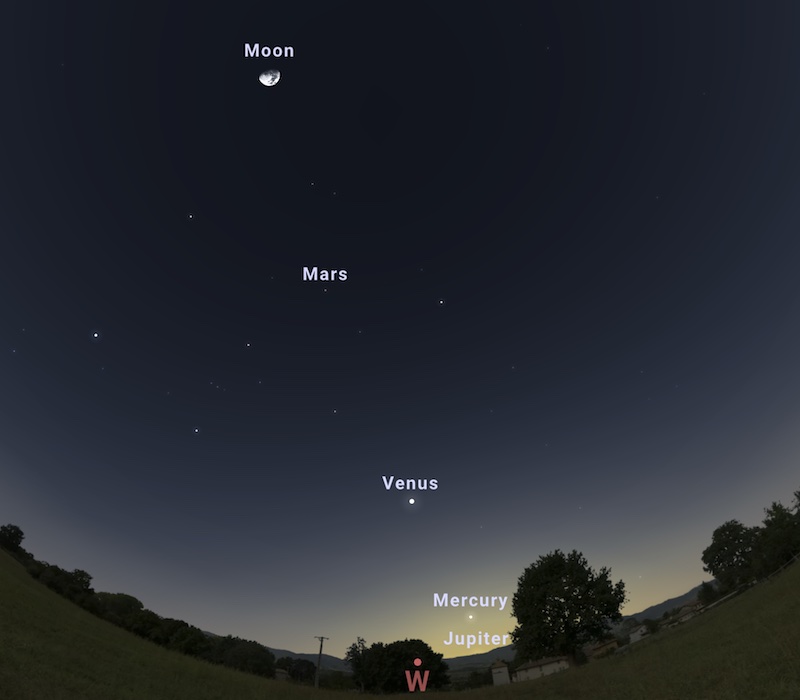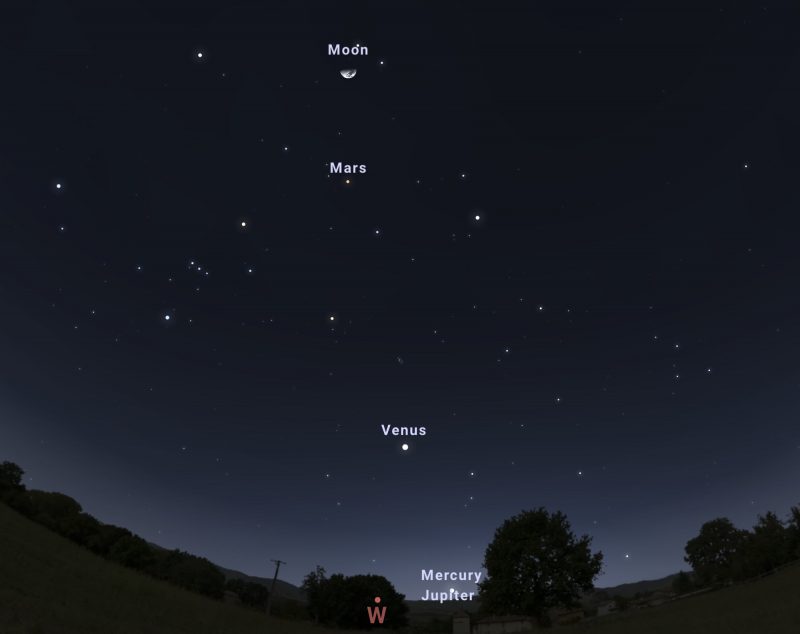Science
After sunset, see the 5 planets in the sky or via video

|
|
How to see 5 planets
This week (late March 2023), you can see five planets lined up in our evening sky: Venus and Uranus, Jupiter and Mercury and Mars. Gianluca Massi of the Virtual Telescope Project in Rome, Italy, showed them through a telescope earlier today (March 29). To enjoy his presentation, watch the video below. In addition, you can see them in the sky, perhaps, if your sky conditions are very good, and you have a sharp eye.
As soon as the sun sets, the planets are positioned in a gentle arc across the evening sky, following the sun’s path across our sky. Likewise, the Moon and the planets also follow the eclipse.
How can we see the planets? Go out around sunset and look west. Among them you can easily spot the bright planet Venus.
Then use binoculars to scan the planet Uranus next to Venus.
Then aim your binoculars low in the sky, near the point where the sun is setting. That is where you will find Jupiter and Mercury.
Then look high in the sky — still see the eclipse or the path of the Sun — to Mars.
Guide to Planetary Viewing
Venus and Uranus. Of these five planets, Venus is the brightest and Uranus is the dim. These two are close together in the sky. Venus is easily visible to the eye. It is the first “star” (actually, planet) to come into view. Uranus shines at +5.8 magnitudes. This is theoretically obvious. But, in practice, you need a dark sky and a telescope to find it. It was roughly 1.5 degrees or three moon widths from Venus earlier this week. Uranus will be closest to Venus on Thursday, March 30.
Thursday and Wednesday. Jupiter is the 2nd brightest planet. But it is now near sunset and visible only in bright twilight. Bright twilight skies make Jupiter more difficult to find. But Jupiter is still visible to the naked eye very close to sunset. And Wednesday? It is fainter than Jupiter (though still brighter than most stars). But it is near sunset. Shortly after sunset, start looking for the pair on the western horizon. You need clear skies and an unobstructed western view to catch them. A telescope should help. They disappear only 30 minutes after sunset. So, when the sun sets, the clock chimes.
tuesday, now the 5th planet in the evening sky, was easy to spot earlier this week because it’s not far from the Moon in our sky’s dome. A bright red light near the moon on Tuesday evening, March 28, 2023. Mars is bright. It is brighter than most stars. And it is clearly red. Even after the sun goes away, you can still spot Mars by its color and by the fact that it doesn’t shine like stars.
Some inventor charts
























Bottom line: You have a chance to see five planets tonight and throughout this week. Here are illustrations and information, including where to look in the video.
For more celestial events, visit EarthSky’s Night Sky Guide.





Science
Giant prehistoric salmon had tusk-like teeth for defence, building nests


|
|
The artwork and publicity materials showcasing a giant salmon that lived five million years ago were ready to go to promote a new exhibit, when the discovery of two fossilized skulls immediately changed what researchers knew about the fish.
Initial fossil discoveries of the 2.7-metre-long salmon in Oregon in the 1970s were incomplete and had led researchers to mistakenly suggest the fish had fang-like teeth.
It was dubbed the “sabre-toothed salmon” and became a kind of mascot for the Museum of Natural and Cultural History at the University of Oregon, says researcher Edward Davis.
But then came discovery of two skulls in 2014.
Davis, a member of the team that found the skulls, says it wasn’t until they got back to the lab that he realized the significance of the discovery that has led to the renaming of the fish in a new, peer-reviewed study.
“There were these two skulls staring at me with sideways teeth,” says Davis, an associate professor in the department of earth sciences at the university.
In that position, the tusk-like teeth could not have been used for biting, he says.
“That was definitely a surprising moment,” says Davis, who serves as director of the Condon Fossil Collection at the university’s Museum of Natural and Cultural History.
“I realized that all of the artwork and all of the publicity materials and bumper stickers and buttons and T-shirts we had just made two months prior, for the new exhibit, were all out of date,” he says with a laugh.
Davis is co-author of the new study in the journal PLOS One, which renames the giant fish the “spike-toothed salmon.”
It says the salmon used the tusk-like spikes for building nests to spawn, and as defence mechanisms against predators and other salmon.
The salmon lived about five million years ago at a time when Earth was transitioning from warmer to relatively cooler conditions, Davis says.
It’s hard to know exactly why the relatives of today’s sockeye went extinct, but Davis says the cooler conditions would have affected the productivity of the Pacific Ocean and the amount of rain feeding rivers that served as their spawning areas.
Another co-author, Brian Sidlauskas, says a fish the size of the spike-toothed salmon must have been targeted by predators such as killer whales or sharks.
“I like to think … it’s almost like a sledgehammer, these salmon swinging their head back and forth in order to fend off things that might want to feast on them,” he says.
Sidlauskas says analysis by the lead author of the paper, Kerin Claeson, found both male and female salmon had the “multi-functional” spike-tooth feature.
“That’s part of our reason for hypothesizing that this tooth is multi-functional … It could easily be for digging out nests,” he says.
“Think about how big the (nest) would have to be for an animal of this size, and then carving it out in what’s probably pretty shallow water; and so having an extra digging tool attached to your head could be really useful.”
Sidlauskas says the giant salmon help researchers understand the boundaries of what’s possible with the evolution of salmon, but they also capture the human imagination and a sense of wonder about what’s possible on Earth.
“I think it helps us value a little more what we do still have, or I hope that it does. That animal is no longer with us, but it is a product of the same biosphere that sustains us.”
This report by The Canadian Press was first published April 24, 2024.
Brenna Owen, The Canadian Press





Science
Giant prehistoric salmon had tusk-like spikes used for defence, building nests: study


|
|
A new paper says a giant salmon that lived five million years ago in the coastal waters of the Pacific Northwest used tusk-like spikes as defense mechanisms and for building nests to spawn.
The initial fossil discoveries of the 2.7-metre-long salmon in Oregon in the 1970s were incomplete and led researchers to suggest the fish had fang-like teeth.
The now-extinct fish was dubbed the “saber-tooth salmon,” but the study published in the peer-reviewed journal PLOS One today renames it the “spike-toothed salmon” and says both males and females possessed the “multifunctional” feature.
Study co-author Edward Davis says the revelation about the tusk-like teeth came after the discovery of fossilized skulls at a site in Oregon in 2014.
Davis, an associate professor in the department of earth sciences at the University of Oregon, says he was surprised to see the skulls had “sideways teeth.”
Contrary to the belief since the 1970s, he says the teeth couldn’t have been used for any kind of biting.
“That was definitely a surprising moment,” Davis says of the fossil discovery in 2014. “I realized that all of the artwork and all of the publicity materials … we had just made two months prior, for the new exhibit, were all out of date.”





Science
SpaceX sends 23 Starlink satellites into low-Earth orbit


|
|
April 23 (UPI) — SpaceX launched 23 Starlink satellites into low-Earth orbit Tuesday evening from Space Launch Complex 40 at Cape Canaveral Space Force Station in Florida.
Liftoff occurred at 6:17 EDT with a SpaceX Falcon 9 rocket sending the payload of 23 Starlink satellites into orbit.
The Falcon 9 rocket’s first-stage booster landed on an autonomous drone ship in the Atlantic Ocean after separating from the rocket’s second stage and its payload.
The entire mission was scheduled to take about an hour and 5 minutes to complete from launch to satellite deployment.
The mission was the ninth flight for the first-stage booster that previously completed five Starlink satellite-deployment missions and three other missions.





-



 Health21 hours ago
Health21 hours agoRemnants of bird flu virus found in pasteurized milk, FDA says
-
News18 hours ago
Amid concerns over ‘collateral damage’ Trudeau, Freeland defend capital gains tax change
-
Art22 hours ago
Random: We’re In Awe of Metaphor: ReFantazio’s Box Art
-
Art15 hours ago
The unmissable events taking place during London’s Digital Art Week
-



 Politics19 hours ago
Politics19 hours agoHow Michael Cohen and Trump went from friends to foes
-
Tech22 hours ago
Surprise Apple Event Hints at First New iPads in Years
-
Science20 hours ago
NASA hears from Voyager 1, the most distant spacecraft from Earth, after months of quiet
-
Media21 hours ago
Vaughn Palmer: B.C. premier gives social media giants another chance





